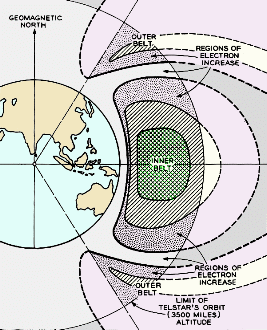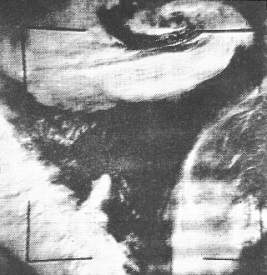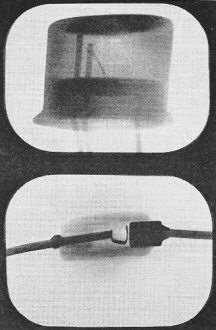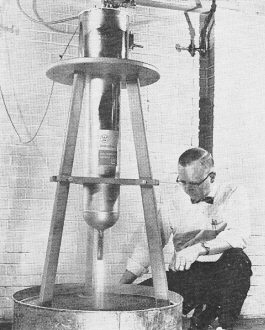News Briefs |
|
The April 1963 edition of Radio−Electronics magazine had many notable items in its monthly News Briefs feature. Radio communications was rapidly replacing wired communications was a primary means of transferring information from point to point. A mere two decades earlier, troops on the battlefield were unrolling spools of wire over the ground sometimes for miles to facilitate phone systems at strategic locations. By the time this News Briefs appeared, international and intercontinental communications radio was the realm primarily of military, government, and amateur radio operators. A lack of understanding of the upper atmosphere's physical properties, with their constantly varying parameters based on solar activity, prevented a commitment to long distance wireless. The International Geophysical Year (IGY) effort in the late 1950's saw great leaps of knowledge which were being exploited at a rapid rate in order to reduce reliance on extreme undersea and overground communications cable. An explosive demand for TV programming was a big driver. Another item of note is the growing use of x−rays for routine component inspection and failure analysis. Reported here is the use of a potassium dihydrogen phosphate (KDP) crystal (sounds like a power source for the Starship Enterprise*) laser used to transfer television programs. New Briefs: 11/1957 | 8/1958 | 11/1959 | 2/1960 | 4/1960 | 8/1960 | 3/1961 | 5/1961 | 6/1961 | 12/1961 | 3/1963 | 4/1963 | 8/1963 | 9/1963 | 8/1964 | 12/1964 | 1/1967 | 3/1967 | 4/1967 | 9/1967 | 4/1968 News Briefs
Increase in electron activity in the Van Allen belts is shown by the dotted area. (Only the regions actually traversed by Telstar are shaded.) The heavier shading indicates greater electron intensity inside the belts, and the crosshatched region is the area that had an electron flux of 800 million per square centimeter per second in July.
Storm vortex is shown in this TV picture taken by TIROS V on Dec. 5, 1962. A dangerous formation is shown, with an unusual swirling mass of clouds. A "slot-cutting mechanism" between the inner and outer Van Allen belts works to decrease the number of electrons in the area more rapidly than ordinary decay would account for. This was told to the American Physical Society by Walter L. Brown of the Bell Laboratories Semiconductor Research Dept. He said that immediately after the Russian high-altitude nuclear tests of Oct. 22 and 28, the gap or slot between the two Van Allen belts was nearly filled up with energetic electrons, the increase of electrons in the gap being greater than that in the belts themselves. Before the tests, there were about 3 million electrons per centimeter per second on the magnetic field line crossing the equator at 4,500 miles altitude. After the second explosion, the number had increased to some 500 million electrons. When Telstar first went into orbit in July, shortly after the Starfish test, the flux of electrons at the peak of the Van Allen belt was even higher - about 800 million electrons per square centimeter per second. From that time to October, electron intensity in the slot between the two belts showed a decay rate to the date of the Russian tests. The nature of the mechanism that appears to be at work, cutting the slot between the two Van Allen belts, is still unknown-in fact, scientists do not know why there are two belts instead of a single broad one. TIROS Makes TV Pictures of Earth's Cloud Cover TIROS - Television Infra-Red Observation Satellite - transmitted more than 203,000 TV pictures of the earth's cloud cover through the end of 1962, NASA discloses. The TIROS meteorological system was developed, tested and produced by RCA for NASA under the direction of Goddard Space Flight Center. Since April 1960, six TIROS satellites have been successfully launched and orbited in six tries. They have logged 1,157 days of useful life, reporting on ice floes, giving advance warning of hurricanes and other weather. phenomena, and supplying data for intra governmental use. Some have been used in launch support of deep-space probes like Mariner and Ranger. TIROS V and VI, still operating, are supplying operational weather data and serving as vehicles for further research. The record shows, say RCA engineers, that TV space observations are feasible and that longevity in space is possible. NASA cites TIROS as an example of the use of space for peaceful purposes. New Device Combines Tube and Transistor Features RCA has announced the development of a "revolutionary solid-state element, combining the best properties of transistors and vacuum tubes." Called a metal oxide semiconductor transistor, it is described as an "insulated-gate, field-effect transistor, made of silicon and capable of amplifying electric voltages," by Dr. William M. Webster, director of RCA Laboratories electronic research program. "By varying the input voltage on the insulated gate," said Dr. Webster, "the device as a whole can be made to switch, amplify or otherwise regulate its output of electric current in a manner analogous to a pentode vacuum tube." In conventional transistors, he explained, similar results are achieved by varying the input current. While voltage-control led transistors are not new in principle, Dr. Webster explained, their great promise has gone largely unrealized because of high production costs, technological difficulties, and the early popularity of current-controlled transistors. The new device will be especially applicable to integrated circuitry. (Arrays of up to 850 of them have been produced in an area the size of a dime.) Integrated circuitry with these components may make portable, battery-operated, high-speed computers possible, as well as a host of applications in communications systems, military and industrial equipment of small size, operating over wide temperature ranges, with great resistance to nuclear radiation. A vidicon camera tube that can be used to detect flaws inside Va 1/8-inch-thick metal casings is now being sold by the Machlett Laboratories, Inc., an affiliate of Raytheon. How it can be used to check electronic parts is shown in the photos. The open circuit in the diode appears very clearly. The new tube is also extremely useful in medical studies, as well as in some nondestructive testing applications. The new tube, labeled ML-589, uses an X-ray-sensitive layer as its sensor element, instead of the light-sensitive, photoconductive layer of ordinary vidicons. Interchangeable with standard vidicons, it is 1 inch in diameter and 6 inches long. It requires an adequate source of X-ray "light". The detailed resolution is comparable to that of fine-grade, high-contrast radiographic film, making the tube suitable for high-resolution applications and magnification up to 50X. MPATI Asks More Channels The Midwest Program for Airborne Television Instruction has asked for six permanent uhf channels, proposing to transform the project from its present experimental basis to a regular operation broadcasting 180 hours per week. The program has been operating for a year and a half, with two separate programs - on channels 72 and 76 - transmitted simultaneously from a plane flying over Montpelier, Ind., and sending lessons received in six states, over an area holding more than 7 million students. The proposed six-channel system will make more efficient coverage possible and lower the cost per student hour. First TV Transmission Over Laser Beam The first transmission of television on a microwave-modulated laser beam was demonstrated Feb. 20 at the General Telephone & Electronics Laboratories, Bayside, N. Y. Two new developments made the breakthrough possible. The first: an electro-optic modulator, a metallic cylinder not more than about 2 inches in diameter and 2 inches long, with holes in the ends and a small potassium dihydrogen phosphate (KDP) crystal at its center. The second is a microwave photodetector developed by the Microwave Devices Div. of Sylvania. In the demonstration, the video signal from an ordinary TV receiver was fed to a traveling-wave tube that was being driven at the same time at 3,000 megacycles by a klystron oscillator. The TV-modulated 3,000-mc signal was amplified and applied through a waveguide to the modulator, which is a resonant cavity at 3,000 mc. The beam from a gas laser passed through the holes in the ends of the cavity and through the crystal at its center, emerging from the cavity as an intensity-modulated optical carrier containing the microwave signal and the television information that was impressed on it. The laser beam was then directed onto the photo detector, a special type of traveling-wave guide with a photo-sensitive cathode. The laser light striking the cathode produced an electron beam containing the microwave sub carrier and the video information. The tube's output was further amplified and fed to a video detector, thence to a TV monitor for display. It was pointed out by Dr. Lee L. Davenport, president of GT & E, that the system was probably several years from practical application, but that the ultimate possibilities were fantastic. More than 160 TV channels or 100,000 telephone channels could be carried on a single laser beam, he said, as compared with 10 TV channels or 6,000 simultaneous telephone conversations possible with the best microwave systems of today. English Slant on Educational TV Charley Bayley, 80, of Black-pool, England, credits television with helping him get an education. "I got so sick of the programs," he said, "that one night I shut the thing down and signed up at a night school." That happened 5 years ago, and now he has certificates of proficiency in English, French, mathematics and Latin. * Dilithium crystals are a fictional power source that are commonly featured in the Star Trek franchise. They are depicted as a rare, naturally occurring mineral that is capable of regulating the matter-antimatter reactions that power the engines of Starfleet vessels. In the Star Trek universe, dilithium crystals are essential to interstellar travel, as they allow ships to safely navigate at faster-than-light speeds without catastrophic power failure. While dilithium crystals are purely fictional, they are a notable example of the many futuristic technologies imagined by the creators of Star Trek. The concept of dilithium crystals has become a cultural touchstone, and the phrase "dilithium crystals" is often used in popular culture to represent a powerful and valuable resource. - ChapGPT
Posted March 6, 2023 |
|

 Telstar Reports on Van Allen Belts
Telstar Reports on Van Allen Belts



